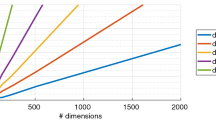Abstract
Human control of high degree-of-freedom robotic systems can often be difficult due to a sparse control problem. This problem relates to the disparity in the amount of information required by the robot’s control variables and the relatively small volume of information a human can specify. To address the sparse control problem, we propose the use of subspaces embedded within the pose space of a robotic system. Driven by human motion, our approach is to uncover 2D subspaces using dimension reduction techniques that allow cursor control, or eventually decoding of neural activity, to drive a robotic hand. We investigate the use of five dimension reduction and manifold learning techniques to estimate a 2D subspace of hand poses for the purpose of generating motion. The use of shape descriptors for representing hand pose is additionally explored for dealing with occluded parts of the hand during data collection. We demonstrate the use of 2D subspaces of power and precision grasps for driving a physically simulated hand from 2D mouse input.
Similar content being viewed by others
Explore related subjects
Discover the latest articles, news and stories from top researchers in related subjects.References
Afshar P, Matsuoka Y (2004) Neural-based control of a robotic hand: evidence for distinct muscle strategies. In: IEEE international conference on robotics and automation)
Arkin RC (1998). Behavior-based robotics. MIT Press, Cambridge
Bengio Y, Paiement JF, Vincent P (2003) Out-of-sample extensions for lle, isomap, mds, eigenmaps, and spectral clustering. In: Advances in neural information processing systems, vol 16 (NIPS 2003). Vancouver, British Columbia
Bitzer S, van der Smagt P (2006) Learning emg control of a robotic hand: towards active prostheses. In: IEEE international conference on robotics and automation
Ciocarlie M, Goldfeder C, Allen P (2007) Dimensionality reduction for hand-independent dexterous robotic grasping. In: IEEE international conference on intelligent robots and systems
Crawford B, Miller K, Shenoy P, Rao R (2005) Real-time classification of electromyographic signals for robotic control. In: National conference on artificial intelligence (AAAI 2006)
Cutkosky M (1989). On grasp choice, grasp models and the design of hands for manufacturing tasks. IEEE Trans Robot Autom 5(3): 269–279
Donoghue J, Nurmikko A, Friehs G, Black M (2004) Development of neural motor prostheses for humans. Adv Clin Neurophysiol (Supplements to Clinical Neurophysiology) 57
Donoho D and Grimes C (2003). Hessian eigenmaps: locally linear embedding techniques for high-dimensional data. Proc. Nati Acad Sci 100(10): 5591–5596
Duda RO, Hart PE, Stork DG (2000) Pattern classification, 2nd ed. Wiley-Interscience
Hochberg L, Serruya M, Friehs G, Mukand J, Saleh M, Caplan A, Branner A, Chen D, Penn R and Donoghue J (2006). Neuronal ensemble control of prosthetic devices by a human with tetraplegia.. Nature 442: 164–171
Iberall T, Sukhatme GS, Beattie D, Bekey GA (1994) On the development of emg control for a prosthesis using a robotic hand. In: IEEE international conference on robotics and automation, San Diego, pp 1753–1758
Jenkins OC, Matarić MJ (2004) A spatio-temporal extension to Isomap nonlinear dimension reduction. In: The international conference on machine learning (ICML 2004), Banff, pp 441–448
Kim H, Biggs S, Schloerb D, Carmena J, Lebedev M, Nicolelis M and Srinivasan M (2006). Continuous shared control stabilizes reach and grasping with brain-machine interfaces. IEEE Trans Biomed Eng 53(6): 1164–1173
Lin J, Wu Y, Huang T (2000) Modeling the constraints of human hand motion. In: IEEE workshop on human motion
Mason CR, Gomez JE and Ebner TJ (2001). Hand synergies during reach-to-grasp. J Neurophysiol 86(6): 2896–2910
Myers CS and Rabiner LR (1981). A comparative study of several dynamic time-warping algorithms for connected word recognition.. Bell System Tech J 60(7): 1389–1409
del R. Millan J, Renkens F, Mourino J and Gerstner W (2004). Brain-actuated interaction. Artif Intell 159(1–2): 241–259 doi: 10.1016/j.artint.2004.05.008
Santhanam G, Ryu SI, Yu BM, Afshar A and Shenoy KV (2006). A high-performance brain–computer interface. Nature 442: 195–198
Serruya M, Caplan A, Saleh M, Morris D, Donoghue J (2004) The braingate pilot trial: building and testing a novel direct neural output for patients with severe motor impairment. In: Soc for Neurosci Abstr
Serruya MD, Hatsopoulos NG, Paninski L, Fellows MR and Donoghue JP (2002). Brain–machine interface: instant neural control of a movement signal. Nature 416: 141–142
Taylor D, Tillery SH and Schwartz A (2003). Information conveyed through brain control: Cursor versus robot. IEEE Trans Neural Systems Rehab Eng 11(2): 195–199
Tenenbaum JB, de Silva V and Langford JC (2000). A global geometric framework for nonlinear dimensionality reduction. Science 290(5500): 2319–2323
Todorov E, Ghahramani Z (2004) Analysis of the synergies underlying complex hand manipulation. In: Intl conference of the IEEE engineering in medicine and biology society
Tsoli A, Jenkins OC (2007) 2d subspaces for user-driven robot grasping. In: Robotics: science and systems - robot manipulation: sensing and adapting to the real world
Wrotek P, Jenkins O, McGuire M (2006) Dynamo: dynamic data-driven character control with adjustable balance. In: ACM SIGGRAPH video game symposium, Boston
Zecca M, Micera S, Carrozza MC and Dario P (2002). Control of multifunctional prosthetic hands by processing the electromyographic signal. Crit Rev Biomed Eng 30(4–6): 459–485
Zordan VB, Horst NCVD (2003) Mapping optical motion capture data to skeletal motion using a physical model. In: SCA ’03: proceedings of the 2003 ACM SIGGRAPH/eurographics symposium on computer animation. Eurographics Association, Aire-la-Ville, pp 245–250
Author information
Authors and Affiliations
Corresponding author
Additional information
This work was supported in part by ONR Award N000140710141, ONR DURIP “Instrumentation for Modeling Dexterous Manipulation”, and NSF Award IIS-0534858.
Rights and permissions
About this article
Cite this article
Jenkins, O.C. Sparse control for high-DOF assistive robots. Intel Serv Robotics 1, 135–141 (2008). https://doi.org/10.1007/s11370-007-0013-0
Received:
Accepted:
Published:
Issue Date:
DOI: https://doi.org/10.1007/s11370-007-0013-0




